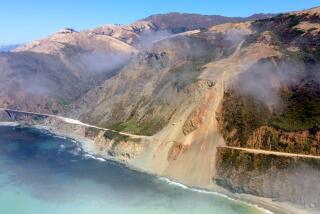Widen Ortega Highway? Some Won’t Go There
Ortega Highway has for years been one of California’s deadliest roads -- 30 miles of twisting narrow asphalt, plunging cliffs, say-a-prayer blind spots and heavy commuter traffic meandering through the mountains of south Orange County.
Now, transportation officials are considering a multibillion-dollar plan to widen the antiquated two-lane road to relieve congestion on the Riverside Freeway -- the primary transportation corridor connecting Orange County and the fast-growing Inland Empire.
But Ortega Highway is going to be a tough road to tame.
Its slim right-of-way squeezes through the tight gorges and steep slopes of the Santa Ana Mountains, presenting builders with significant engineering hurdles.
The highway crosses some of the most sensitive wildlife habitat in Southern California, including the San Juan Creek watershed, the Cleveland National Forest and Ronald W. Caspers Wilderness Park. The San Mateo Canyon Wilderness is nearby.
Municipal officials in south Orange County are mindful of the Riverside Freeway’s growing congestion. But they aren’t enthusiastic about proposals that could nearly quadruple traffic from the Inland Empire to their cities and Interstate 5 -- a freeway, planners say, that is overtaxed and needs its own expensive overhaul.
“We just can’t be a receptacle for more motorists from Riverside [County],” said Sam Allevato, a San Juan Capistrano councilman. “The project would destroy the scenic character of the Ortega. And it’s so narrow in spots there’s barely room for two lanes, let alone four.”
The proposal to super-size Ortega Highway is one of several options pending before a committee of policymakers and transportation officials from the two counties interested in developing alternatives to the Riverside Freeway -- the stretch of California 91 from the 60 Freeway in Riverside to the I-5.
Traffic on the Riverside Freeway is expected to almost double in the next 25 years, from 260,000 vehicles a day to about 450,000, most of them Inland Empire residents commuting to jobs in Orange and Los Angeles counties.
Other options include expanding public transit, widening the Riverside Freeway to as many as 17 lanes, building a new highway paralleling the 91 and digging a 12-mile tunnel under Cleveland National Forest from Cajalco Road in Riverside County to California 133 in Irvine. The committee is to decide on the proposals in December.
Improvements to the Ortega would include widening the highway to four lanes from Lake Elsinore to several miles east of San Juan Capistrano at a proposed Foothill South tollway, a turnpike from Oso Parkway east of Mission Viejo to the I-5 near San Clemente. The 10-foot-wide lanes would be increased to the standard 12 feet. Shoulders would be added to help prevent cars from tumbling down the mountainside -- a not-uncommon mishap along the Ortega.
“There’re so many accidents, you can get over the top of the mountains and have to turn right around and go all the way back,” said Joe Narciso, 44, a state building inspector from Wildomar who commutes over the Ortega. “The improvements are needed bad.”
Although the alignment hasn’t been determined, planners say two new lanes might be built in tunnels on the north side of San Juan Creek. To avoid the Ortega’s spiraling descent into Lake Elsinore, planners are considering a tunnel bypass that would connect to Interstate 15.
The cost to widen the Ortega would be about $3 billion, a figure that doesn’t include extensive environmental protections that would be required for the wilderness areas, national forest and the San Juan Creek watershed. Those areas are home to centuries-old stands of oak, mountain lions and 20 threatened species of plants and animals, such as the arroyo toad and southern steelhead trout.
Planners say the expanded road would accommodate at least 35,000 vehicles a day -- nearly four times its capacity now.
Over the last decade, the Ortega has emerged as a secondary commuter link to Orange County from southern Riverside County, a purpose it was never designed for when the highway was built in 1929 along an old Indian trail.
In such tight quarters, cars and trucks sometimes sideswipe each other, ripping off side-view mirrors, door handles and trim. Motorists who pass illegally often force other drivers to hug the guardrails or hillsides to avoid getting hit.
At rush hour “it’s a steady line of cars,” said Steve Bobbett, 53, of Lake Elsinore. “The road is narrow and winding and a lot of people just don’t know how to drive it.”
On weekends, the highway takes on another personality. Car clubs, sightseers, campers and trucks hauling boats compete for road space with high-performance motorcycles that weave in and out of traffic.
Compared to similar state routes, the risk of death or serious injury on the Ortega is among the highest for motorists.
Because of engineering, financial and environmental constraints, the California Department of Transportation has concentrated largely on making the Ortega safer. In 2007, Caltrans plans to upgrade the highway’s most dangerous section: Ricochet Alley, so named because drivers who lose control here carom off the guardrails and sheer rock walls into traffic.
Widening just two lanes along that 3.3-mile stretch would take two years and cost $27 million. But a major project, said Ahmed Abou-Abdou, a Caltrans project manager, would be “exponentially more expensive.”
H. Tony Rahimian, an Irvine-based civil engineer who is coordinating the study committee, agreed. Overhauling 20 to 30 miles of the Ortega, he said, would be “extremely difficult” because of its looping turns, mountainous setting and San Juan Creek.
The new lanes would require blasting through granite, building viaducts over the creek, retaining walls to hold up slopes and extensive excavation of the steep mountainsides. Heavy equipment would be harder to operate in the narrow right of way, and historic structures such as the San Juan Creek Bridge, built more than 70 years ago, would have to be preserved.
Tunneling, Rahimian said, would be costly and add another dimension of uncertainty during construction.
“There is a safety problem on the Ortega that needs to be addressed,” said San Juan Capistrano Councilman Dave Swerdlin, who, like other south Orange County politicians, questions the widening proposal. “But should it become a major artery? I would have to question that.”
San Juan Capistrano, known for its Spanish mission and adobe buildings, notified the Riverside Freeway’s study committee in July that widening the Ortega would threaten the town’s historic setting and quality of life.
During rush hour, traffic from the road already backs up through San Juan Capistrano, clogging the highway’s outmoded interchange with I-5 near downtown.
Meanwhile, traffic has surged on the 5 through south Orange County. Motorists make as many as 390,000 trips a day on some sections of the highway.
Widening Ortega “would have an overwhelming impact on Interstate 5 and the commutes for south Orange County residents,” said Laguna Niguel Councilwoman Cathryn DeYoung, a former Orange County Transportation Authority director.
“They need to show us how to fix the 5,” said DeYoung, who is running for county supervisor, “before they dump another 25,000 motorists a day down here.”
Other local politicians also question whether it is worth spending $3 billion on the Ortega to accommodate only 25,000 more vehicle trips a day.
Swerdlin and others say the money could be better spent elsewhere, such as the Cajalco tunnel under Cleveland National Forest, getting far more Riverside County commuters to central and northern Orange County, where the jobs are.
The latest estimate for the Cajalco tunnel is at $5 billion to $6 billion if six lanes are built. Planners say it could handle 100,000 vehicle trips a day, less if tolls are charged.
In south Riverside County, the perspective is different. Cities such as Temecula, Murrieta, Hemet and Lake Elsinore want the Ortega widened. Those towns have seen an explosive population growth in the last decade -- 18% to 20% a year.
The power brokers and business interests want the transportation solutions to be north of Lake Elsinore, such as widening the Riverside Freeway and building the Cajalco tunnel, said Lake Elsinore Mayor Bob Magee, who sits on the Riverside County Transportation Commission and the study committee.
“The tunnel might be too expensive, and the solution is far away,” Magee said.
“An overland alternative” -- fixing the Riverside Freeway and Ortega Highway -- “can happen cheaper and quicker” even with the required environmental protections, he said.
Magee conceded that south Orange County cities have realistic concerns about potential increases in traffic from Riverside County.
But improving the Ortega would bring more traffic from Orange County to the Lake Elsinore area as well -- a trend, Magee said, that could benefit local business.
“We want people to come to see our lake, our outlet malls and our baseball team,” Magee said, referring to the minor league Lake Elsinore Storm. “We hope we get the same level of attention and consideration [by policymakers] as south Orange County.”
More to Read
Sign up for Essential California
The most important California stories and recommendations in your inbox every morning.
You may occasionally receive promotional content from the Los Angeles Times.










